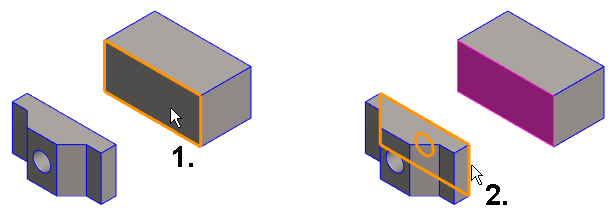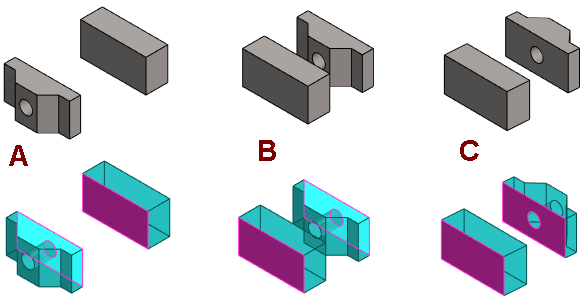Add a Distance Constraint
General
- Define a distance constraint by clicking the element (face, line or point) to be affected by the constraint on both parts.
- A variable or formula can be given to the constraint if the distance is to be controlled using a dimension table.
- The constraint can be given a start and end value and the number of steps if the constraint is to be simulated between the start and end values.
- If the result is not what you expected, you can flip the Distance constraint or change its side.

Add an distance constraint between parts
- Select Assembly | Constraints |
 Distance constraint.
Distance constraint. - Select a face, line, or a point from the first part (1).
- Select a face, line, or a point from the second part (2).
- The program opens a dialog box: Edit constraint.
- See editing constraints: Edit Constraint
- Edit the value of the distance in the dialog box.
- Enter the variable or formula, if you want to control the distance by using the assembly dimension table.
- See dimension tables: Different Dimension Tables
- Enter the start and end values and the number of steps if you want to simulate the movement between two different distances.
- See simulation: Simulate an Assembly Constraint
- Select OK.
- The program moves the parts to the location defined by the constraint.
- If the position of the parts is not satisfactory, you can select the functions from the auxiliary menu:
 Change side of previous constraint changes the side of the constraint.
Change side of previous constraint changes the side of the constraint. Flip previous constraint flips the constraint.
Flip previous constraint flips the constraint. An earlier constraint may prevent the changing of side or flipping.
An earlier constraint may prevent the changing of side or flipping.
- Continue repeating steps 1 ... 8 until all the desired constraints have been added.
- Stop adding distance constraints:
- Select another function.
- Press the Esc key.
- Press the V key (Confirm).
- Select the context-sensitive function
 OK.
OK. - Click the middle mouse button.
An example of changing the side and flipping of a dimension constraint
- A = The distance is entered.
- B = The side of the constraint is changed.
- C = The constraint is flipped. In this case, the second part flips.

Note:
- You can also use this function by first selecting the two parts, and then
- The ribbon bar function
 Distance or
Distance or - The context-sensitive function Constraints >
 Distance.
Distance. - Select the second part Ctrl+left mouse button.
- The ribbon bar function
- You can undo the constraint last added by using the Undo function or by pressing Ctrl+Z before exiting constraint definition. The previous constraint solution is not restored.
- Zoom the part view by pressing the Z key to select an element. Zoom all by pressing the A key.
- You can specify the Distance constraint as configuration-specific and set limiting values for the dimension constraint. Select the constraint and the context-sensitive function Edit.
- Move a part by moving the cursor onto a part, then moving the mouse while holding down the left mouse button.

